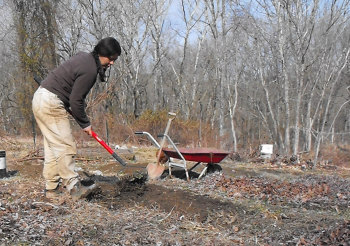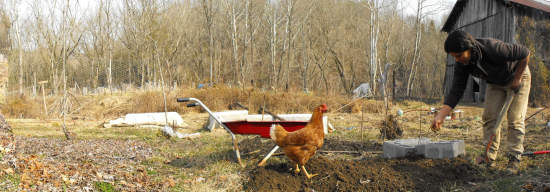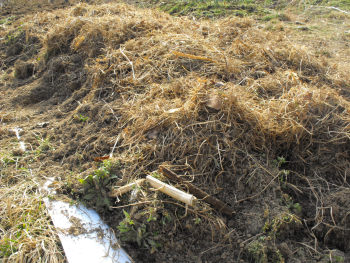
Preparing garden beds
 As Mark puts it, once the gardening year
really gets going, it's like riding a full speed locomotive --- good
luck slowing it down or changing course. I can already feel the
gardening locomotive picking up steam, with 32 beds slated to be
planted in March. (We plan to plant about 125 beds of annual
veggies this year, with the vast majority going in on our frost-free
date in May.)
As Mark puts it, once the gardening year
really gets going, it's like riding a full speed locomotive --- good
luck slowing it down or changing course. I can already feel the
gardening locomotive picking up steam, with 32 beds slated to be
planted in March. (We plan to plant about 125 beds of annual
veggies this year, with the vast majority going in on our frost-free
date in May.)
This week, Mark and I went over to our neighbor's house to collect some
horse manure. We sell the neighbors veggies, and they throw their
peels and tops into a pile with their horse manure, which we then
collect in late winter to put back into the garden. Thursday I
raked 11 beds, removing the weeds and working the half-composted manure
and kitchen scraps into the soil. It would be better to let the
manure compost all the way, but at the rate of 2 gallons per 20 square
feet or so, the worms make short work of any organic matter. (I'd
love to double up on my manure application, but those horses will only
give me so much!)

We try to stick to semi-no-till beds, partly because it's good for the
soil and partly because I just like it. After tilling new ground
the first time, we mound the topsoil up into permanent beds separated
by permanent paths. In a perfect no-till world, I'd have enough
mulch to cover all of these beds in the fall, but in my world I have to
leave most of them bare over the winter. Come late winter or
early spring, I rake off the chickweed, dead nettles, and chamomile
which have sprung up, then plant into the raked soil. Some beds
are a little more weedy, so I spade them up lightly before raking, but
try to keep the soil structure as intact as possible. The
preparation takes about 15 minutes per bed if they need to be
spaded.
 We're only starting a few new
beds this year, and I want to try to make them completely no
till. I worked up one on Thursday afternoon, laying down paper,
then mounding up dirt, and topping it off with manury grass tops the
chickens have pulled up out of their current pasture spot. It
might be a stretch, but I want to try to plant shallow-rooted autumn
plants in this bed in six months. Another experiment....
We're only starting a few new
beds this year, and I want to try to make them completely no
till. I worked up one on Thursday afternoon, laying down paper,
then mounding up dirt, and topping it off with manury grass tops the
chickens have pulled up out of their current pasture spot. It
might be a stretch, but I want to try to plant shallow-rooted autumn
plants in this bed in six months. Another experiment....
Want more in-depth information? Browse through our books.
Or explore more posts by date or by subject.
About us: Anna Hess and Mark Hamilton spent over a decade living self-sufficiently in the mountains of Virginia before moving north to start over from scratch in the foothills of Ohio. They've experimented with permaculture, no-till gardening, trailersteading, home-based microbusinesses and much more, writing about their adventures in both blogs and books.
Want to be notified when new comments are posted on this page? Click on the RSS button after you add a comment to subscribe to the comment feed, or simply check the box beside "email replies to me" while writing your comment.
